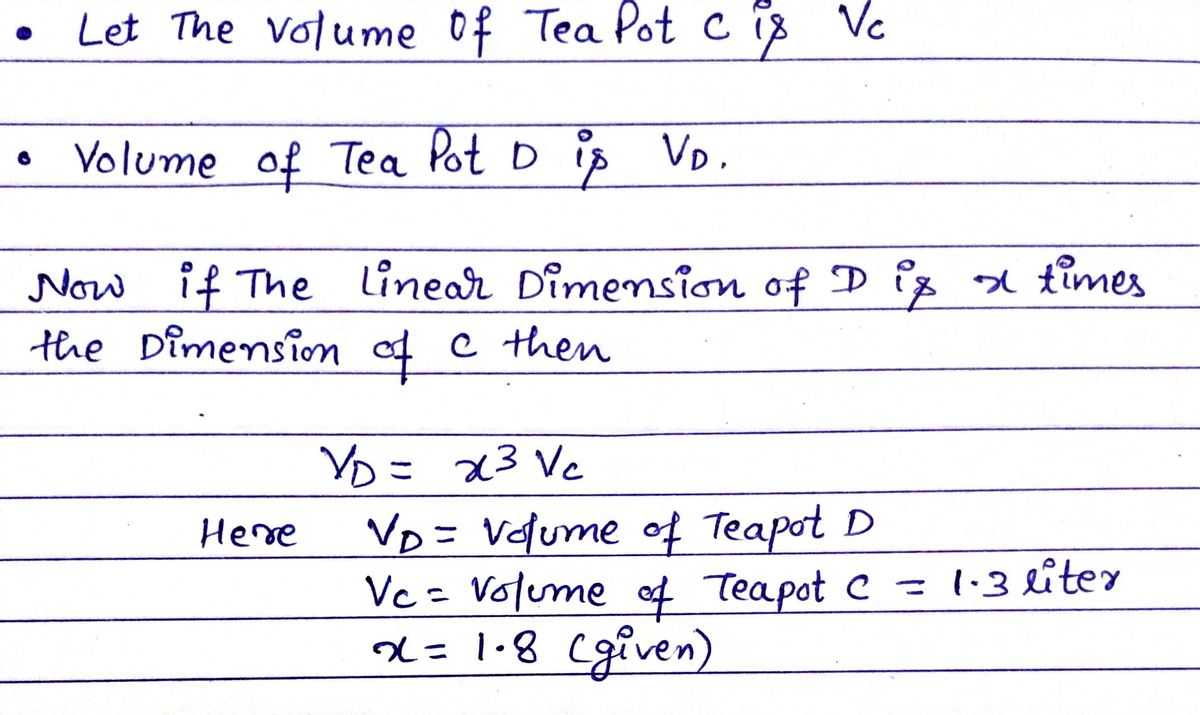d) If teapot C holds 1.3 liters of tea when filled, how much tea does teapot D hold? (Hint: I doubt you will be able to find an exact mathematical formula for the volume of a teapot. Nevertheless, the same type of ratio reasoning you used in parts a)-c) of this problem will still be useful.)
d) If teapot C holds 1.3 liters of tea when filled, how much tea does teapot D hold? (Hint: I doubt you will be able to find an exact mathematical formula for the volume of a teapot. Nevertheless, the same type of ratio reasoning you used in parts a)-c) of this problem will still be useful.)
College Physics
11th Edition
ISBN:9781305952300
Author:Raymond A. Serway, Chris Vuille
Publisher:Raymond A. Serway, Chris Vuille
Chapter1: Units, Trigonometry. And Vectors
Section: Chapter Questions
Problem 1CQ: Estimate the order of magnitude of the length, in meters, of each of the following; (a) a mouse, (b)...
Related questions
Question
100%
Part D only please

Transcribed Image Text:2. This is an example of a scaling problem, in which we examine the effects of changing a parameter by taking
ratios. (You should expect to encounter this type of problem frequently on homework and exams.) Suppose
we have a cylindrical container A, as shown in the picture below.
A
A second container, B, has the same shape as A, but all of its linear measurements are larger by a factor of
1.80-that is, B is 1.80 times as tall as A, and has 1.80 times the radius of A.
Answer the following questions using only appropriate scaling ratios; you should not need to assume specific
numerical values for the original radius and height of the cylinder. Instead, write out the expressions you need
using symbols (e.g., r for the radius), take the ratio, and cancel out as much as you can before plugging in any
numbers. Express all your answers in decimal form, and show your work in each case.
a) This question refers to the circumference of each container. What is the dimensionality of the circumfer-
ence? (i.e., what kind of quantity is it? How can it be expressed in terms of the fundamental dimensions of
length (L), mass (M), and time (T)?) How will the circumference of container B compare with that of container
A-that is, what is the numerical value of the ratio CB/CA?
b) What is the dimensionality of area? How many times larger is the cross-sectional area of B (i.e., the area.
of the base of B, den
SB) than the cross-sectional area SA?
c) What is the dimensionality of volume? If A contains 2.50 liters of water when filled to the brim, how many
liters of water will B contain when filled?
CONTINUED ON NEXT PAGE
Now, let's consider a differently shaped container, such as a teapot. Suppose teapot D has the same shape
and proportions as teapot C, but all of its linear measurements are scaled up by a factor of 1.80-i.e., D is 1.80
times as tall as C, its spout has 1.80 times the radius at its widest point, and so on.
D
d) If teapot C holds 1.3 liters of tea when filled, how much tea does teapot D hold? (Hint: I doubt you will
be able to find an exact mathematical formula for the volume of a teapot. Nevertheless, the same type of ratio
reasoning you used in parts a)-c) of this problem will still be useful.)
Expert Solution
Step 1

Step by step
Solved in 2 steps with 2 images

Knowledge Booster
Learn more about
Need a deep-dive on the concept behind this application? Look no further. Learn more about this topic, physics and related others by exploring similar questions and additional content below.Recommended textbooks for you

College Physics
Physics
ISBN:
9781305952300
Author:
Raymond A. Serway, Chris Vuille
Publisher:
Cengage Learning

University Physics (14th Edition)
Physics
ISBN:
9780133969290
Author:
Hugh D. Young, Roger A. Freedman
Publisher:
PEARSON

Introduction To Quantum Mechanics
Physics
ISBN:
9781107189638
Author:
Griffiths, David J., Schroeter, Darrell F.
Publisher:
Cambridge University Press

College Physics
Physics
ISBN:
9781305952300
Author:
Raymond A. Serway, Chris Vuille
Publisher:
Cengage Learning

University Physics (14th Edition)
Physics
ISBN:
9780133969290
Author:
Hugh D. Young, Roger A. Freedman
Publisher:
PEARSON

Introduction To Quantum Mechanics
Physics
ISBN:
9781107189638
Author:
Griffiths, David J., Schroeter, Darrell F.
Publisher:
Cambridge University Press

Physics for Scientists and Engineers
Physics
ISBN:
9781337553278
Author:
Raymond A. Serway, John W. Jewett
Publisher:
Cengage Learning

Lecture- Tutorials for Introductory Astronomy
Physics
ISBN:
9780321820464
Author:
Edward E. Prather, Tim P. Slater, Jeff P. Adams, Gina Brissenden
Publisher:
Addison-Wesley

College Physics: A Strategic Approach (4th Editio…
Physics
ISBN:
9780134609034
Author:
Randall D. Knight (Professor Emeritus), Brian Jones, Stuart Field
Publisher:
PEARSON